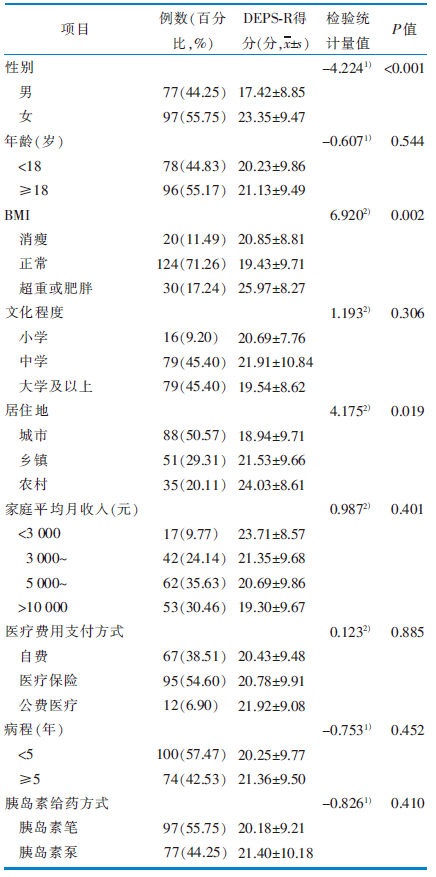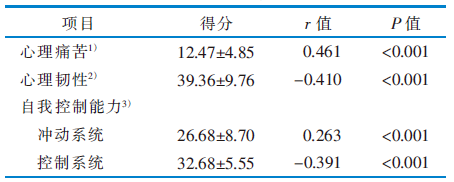


中华护理杂志 ›› 2023, Vol. 58 ›› Issue (8): 956-962.DOI: 10.3761/j.issn.0254-1769.2023.08.009
周美景( ), 王洪, 于健, 朱敏, 罗丹, 施云, 张梅, 徐晶晶(
), 王洪, 于健, 朱敏, 罗丹, 施云, 张梅, 徐晶晶( ), 杨涛
), 杨涛
收稿日期:2022-10-05
出版日期:2023-04-20
发布日期:2023-04-19
通讯作者:
徐晶晶,E-mail:dsnxjj@njmu.edu.cn作者简介:周美景:女,硕士,护师,E-mail:18940860012@163.com
基金资助:
ZHOU Meijing( ), WANG Hong, YU Jian, ZHU Min, LUO Dan, SHI Yun, ZHANG Mei, XU Jingjing(
), WANG Hong, YU Jian, ZHU Min, LUO Dan, SHI Yun, ZHANG Mei, XU Jingjing( ), YANG Tao
), YANG Tao
Received:2022-10-05
Online:2023-04-20
Published:2023-04-19
摘要:
目的 调查青少年1型糖尿病患者饮食行为紊乱现状并分析其影响因素。方法 便利选取于2021年12月—2022年9月在南京市某三级甲等医院复诊的187例青少年1型糖尿病患者作为调查对象,使用一般资料调查表、修订版糖尿病饮食行为紊乱量表、糖尿病相关问题量表-5、青少年糖尿病优势与韧性量表、青少年自我控制双系统量表进行调查,了解其饮食行为紊乱现状,并采用多元线性回归分析相关影响因素。结果 回收有效问卷174份。青少年1型糖尿病患者饮食行为紊乱得分为(21.25±10.93)分,饮食行为紊乱发生率为54.60%。多元线性回归分析结果显示,性别、BMI、心理痛苦、心理韧性和自我控制能力是饮食行为紊乱的影响因素。结论 青少年1型糖尿病患者饮食行为紊乱处于较高水平。医护人员应定期评估患者的饮食行为,尤其是女性、肥胖或超重患者,通过纠正其病态的体型认知、增强其控制疾病的信心,帮助其积极应对压力,减少负性情感体验,进而降低饮食行为紊乱的发生率。
周美景, 王洪, 于健, 朱敏, 罗丹, 施云, 张梅, 徐晶晶, 杨涛. 青少年1型糖尿病患者饮食行为紊乱的调查研究[J]. 中华护理杂志, 2023, 58(8): 956-962.
ZHOU Meijing, WANG Hong, YU Jian, ZHU Min, LUO Dan, SHI Yun, ZHANG Mei, XU Jingjing, YANG Tao. Study on the disordered eating behaviors in adolescents with type 1 diabetes and influencing factors[J]. Chinese Journal of Nursing, 2023, 58(8): 956-962.
 |
表1 青少年1型糖尿病患者的一般资料及饮食行为紊乱的单因素分析(n=174)
Table 1 General information and univariate analysis of disordered eating behaviors in adolescents with type 1 diabetes mellitus(n=174)
 |
 |
表2 青少年1型糖尿病患者饮食行为紊乱与心理痛苦、心理韧性、自我控制能力的相关性分析(分,$\bar{x}±s$)
Table 2 Correlation analysis of disordered eating behaviors with diabetes distress,resilience and self-control in adolescents with type 1 diabetes mellitus(score,$\bar{x}±s$)
 |
| [1] | 中华医学会儿科学分会内分泌遗传代谢学组,中华儿科杂志编辑委员会. 中国儿童1型糖尿病标准化诊断与治疗专家共识(2020版)[J]. 中华儿科杂志, 2020, 58(6):447-454. |
| The Subspecialty Group of Endocrinologic,Hereditary and Metabolic Diseases,the Society of Pediatrics, Chinese Medical Association,the Editorial Board,Chinese Journal of Pediatrics. Expert consensus on the standardized diagnosis and management of type 1 diabetes mellitus in Chinese children(2020)[J]. Chin J Pediatr, 2020, 58(6):447-454. | |
| [2] |
McGuire HC, Ji LN, Kissimova-Skarbek K, et al. Type 1 dia-betes mellitus care and education in China:the 3C study of coverage,cost,and care in Beijing and Shantou[J]. Diabetes Res Clin Pract, 2017, 129:32-42.
DOI URL |
| [3] | 张雨, 高孟娟, 袁举, 等. 1型糖尿病青少年饮食行为紊乱患病率及影响因素的系统评价[J]. 中华糖尿病杂志, 2022, 14(5):440-447. |
| Zhang Y, Gao MJ, Yuan J, et al. Prevalence and influence factors of disordered eating behaviors in type 1 diabetic adolescents:a systematic review[J]. Chin J Diabetes Mellit, 2022, 14(5):440-447. | |
| [4] |
Hagger MS, Orbell S. The common sense model of illness self-regulation:a conceptual review and proposed extended model[J]. Health Psychol Rev, 2022, 16(3):347-377.
DOI URL |
| [5] | 民政部,共青团中央. 青少年社会工作服务指南(全文)[EB/OL]. (2019-07-04)[2023-01-11]. http://laws.swchina.org/standard/2019/0704/34329.shtml. |
| The Ministry of Civil Affairs,the Central Committee of the Communist Youth League. Guidelines for youth social work services(full text)[EB/OL]. (2019-07-04)[2023-01-11]. http://laws.swchina.org/standard/2019/0704/34329.shtml. | |
| [6] | WHO. Global Accelerated Action for the Health of Adolescents (AA-HA):guidance to support country implementation[EB/OL]. (2017-01-01)[2023-01-11]. https://www.who.int/publicationsdetail-redirect/9789241512343. |
| [7] | 沈光辉, 范涌峰, 陈婷. 教育研究中的P值使用:问题及对策,兼谈效应量的使用[J]. 数学教育学报, 2019, 28(4):92-98. |
| Shen GH, Fan YF, Chen T. Using P value in educational research:problems and countermeasures,concurrently discussing about the use of effect quantity[J]. J Math Educ, 2019, 28(4):92-98. | |
| [8] |
Cherubini V, Skrami E, Iannilli A, et al. Disordered eating behaviors in adolescents with type 1 diabetes: a cross-sectional population-based study in Italy[J]. Int J Eat Disord, 2018, 51(8):890-898.
DOI PMID |
| [9] | 国家卫生和计划生育委员会. 学龄儿童青少年营养不良筛查:WS/T 456—2014[S]. 北京: 中国标准出版社, 2014:1-4. |
| National Health and Family Planning Commission. Screening standard for malnutrition of school-age children and adoles-cents:WS/T 456—2014[S]. Beijing: Standards Press of China, 2014:1-4. | |
| [10] | 国家卫生和计划生育委员会. 学龄儿童青少年超重与肥胖筛查:WS/T 586—2018[S]. 北京: 中国标准出版社, 2018:1-3. |
| National Health and Family Planning Commission. Screening for overweight and obesity among school-age children and adolescents:WS/T 586—2018[S]. Beijing: Standards Press of China, 2018:1-3. | |
| [11] | 陈春明, 孔灵芝. 中国成人超重和肥胖症预防控制指南[M]. 北京: 人民卫生出版社, 2006:1-36. |
| Chen CM, Kong LZ. Chinese adult overweight and obesity prevention and control guidelines[M]. Beijing: People’s Medical Publishing House, 2006:1-36. | |
| [12] |
Markowitz JT, Butler DA, Volkening LK, et al. Brief screening tool for disordered eating in diabetes:internal consistency and external validity in a contemporary sample of pediatric patients with type 1 diabetes[J]. Diabetes Care, 2010, 33(3):495-500.
DOI PMID |
| [13] |
Lv WC, Zhong QY, Guo J, et al. Instrument context relevance evaluation,translation,and psychometric testing of the Diabetes Eating Problem Survey-Revised(DEPS-R) among people with type 1 diabetes in China[J]. Int J Environ Res Public Health, 2021, 18(7):3450.
DOI URL |
| [14] |
McGuire BE, Morrison TG, Hermanns N, et al. Short-form measures of diabetes-related emotional distress:the Problem Areas in Diabetes Scale(PAID)-5 and PAID-1[J]. Diabetologia, 2010, 53(1):66-69.
DOI PMID |
| [15] |
Luo D, Xu JJ, Cai X, et al. The effects of family functioning and resilience on self-management and glycaemic control among youth with type 1 diabetes[J]. J Clin Nurs, 2019, 28(23/24):4478-4487.
DOI URL |
| [16] |
Hilliard ME, Iturralde E, Weissberg-Benchell J, et al. The Diabetes Strengths and Resilience Measure for Adolescents with Type 1 Diabetes(DSTAR-teen):validation of a new,brief self-report measure[J]. J Pediatr Psychol, 2017, 42(9):995-1005.
DOI PMID |
| [17] |
罗丹, 徐晶晶, 王玉冰, 等. 青少年1型糖尿病患者心理韧性与其身心状况的关系研究[J]. 中华护理杂志, 2022, 57(3):306-311.
DOI |
|
Luo D, Xu JJ, Wang YB, et al. Association of resilience with glycemic control,diabetes distress,and quality of life among adolescents with type 1 diabetes[J]. Chin J Nurs, 2022, 57(3):306-311.
DOI |
|
| [18] |
Dvorak RD, Simons JS. Moderation of resource depletion in the self-control strength model:differing effects of two modes of self-control[J]. Pers Soc Psychol Bull, 2009, 35(5):572-583.
DOI URL |
| [19] | 谢东杰, 王利刚, 陶婷, 等. 青少年自我控制双系统量表中文版的效度和信度[J]. 中国心理卫生杂志, 2014, 28(5):386-391. |
| Xie DJ, Wang LG, Tao T, et al. Validity and reliability of the Chinese version of the Dual-Mode of Self-Control Scale for Adolescents[J]. Chin Ment Health J, 2014, 28(5):386-391. | |
| [20] |
Sien PLM, Jamaludin NIA, Samrin SNA, et al. Causative factors of eating problems among adolescents with type 1 diabetes mellitus:a qualitative study[J]. J Health Psychol, 2020, 25(9):1310-1318.
DOI URL |
| [21] |
Araia E, Hendrieckx C, Skinner T, et al. Gender differences in disordered eating behaviors and body dissatisfaction among adolescents with type 1 diabetes:results from diabetes MILES youth-Australia[J]. Int J Eat Disord, 2017, 50(10):1183-1193.
DOI URL |
| [22] |
Araia E, King RM, Pouwer F, et al. Psychological correlates of disordered eating in youth with type 1 diabetes:results from diabetes MILES youth-Australia[J]. Pediatr Diabetes, 2020, 21(4):664-672.
DOI URL |
| [23] |
Moskovich AA, Dmitrieva NO, Babyak MA, et al. Real-time predictors and consequences of binge eating among adults with type 1 diabetes[J]. J Eat Disord, 2019, 7:7.
DOI PMID |
| [24] |
Powers MA, Richter SA, Ackard DM, et al. Diabetes distress among persons with type 1 diabetes[J]. Diabetes Educ, 2017, 43(1):105-113.
DOI PMID |
| [25] | Glantz M, Johnson JL. Resilience and development:positive life adaptations[M]. New York: Kluwer Academic, 1999:179-224. |
| [26] |
Luo D, Zhou MJ, Sun LF, et al. Resilience as a mediator of the association between perceived stigma and quality of life among people with inflammatory bowel disease[J]. Front Psychiatry, 2021, 12:709295.
DOI URL |
| [27] |
周美景, 罗丹, 林征, 等. 炎症性肠病患者自我管理行为的影响因素分析[J]. 中华护理杂志, 2021, 56(4):550-555.
DOI |
|
Zhou MJ, Luo D, Lin Z, et al. Analysis of influencing factors of self-management behavior in patients with inflammatory bowel disease[J]. Chin J Nurs, 2021, 56(4):550-555.
DOI |
|
| [28] |
Li XM, Gao Q, Sun LX, et al. Effect of self-control on health promotion behavior in patients with coronary heart disease:mediating effect of ego-depletion[J]. Psychol Health Med, 2022, 27(6):1268-1276.
DOI URL |
| [29] |
Ochsner KN, Gross JJ. The cognitive control of emotion[J]. Trends Cogn Sci, 2005, 9(5):242-249.
DOI PMID |
| [30] | 冯彪, 李宗龙, 王凯欣, 等. 大学生生活目标与心理韧性的关系:自我控制和一般自我效能感的多重中介作用[J]. 心理研究, 2022, 15(1):78-85. |
| Feng B, Li ZL, Wang KX, et al. The relationship between purpose in life and resilience in college students:the multiple mediating roles of self-control and general self-efficacy[J]. Psychol Res, 2022, 15(1):78-85. | |
| [31] | 陶花, 林征, 黄晓萍, 等. 以家庭为中心的护理对青少年糖尿病患者家庭环境及血糖控制的影响[J]. 中华护理杂志, 2014, 49(11):1342-1346. |
| Tao H, Lin Z, Huang XP, et al. The effect of family-centered care on family adaptability and cohesion and glycemic control in adolescents with type 1 diabetes[J]. Chin J Nurs, 2014, 49(11):1342-1346. |
| [1] | 王佩, 张蓝方, 崔怡, 张银玲. 小丑照护在儿科患者中应用的研究进展[J]. 中华护理杂志, 2023, 58(8): 1012-1016. |
| [2] | 崔璀, 郑显兰, 陈文劲, 李双子. 癫痫青少年至成人过渡期准备评估问卷的汉化和信效度检验[J]. 中华护理杂志, 2023, 58(8): 1017-1024. |
| [3] | 刘群慧, 方敏, 黄洁, 刘筝筝, 孙丽, 韦琦, 单媛媛, 黄家丽. 家长参与的绘画疗法在白血病患儿中的应用研究[J]. 中华护理杂志, 2023, 58(8): 907-914. |
| [4] | 廖芳, 陶秀秀, 贲艳丽, 李萍. 新疆维吾尔自治区规范化培训护士工作准备度现状及影响因素分析[J]. 中华护理杂志, 2023, 58(8): 929-934. |
| [5] | 赵宝生, 李振香, 马超群, 王艳艳, 范桂敏, 李涵, 郑晓丽. 青少年自杀未遂患者心理体验质性研究的Meta整合[J]. 中华护理杂志, 2023, 58(8): 979-985. |
| [6] | 何丽, 胡露红, 崔金锐, 邓妍, 褚彦香, 王玮荻, 王倩云. 乳腺癌化疗患者自我倡权能力现状及影响因素分析[J]. 中华护理杂志, 2023, 58(7): 788-793. |
| [7] | 尹艳茹, 周洪昌, 刘梦如, 梁发存, 茹运新, 杨文娟, 宁云凤, 丁敏. 老年维持性血液透析患者社会隔离现状的调查研究[J]. 中华护理杂志, 2023, 58(7): 822-828. |
| [8] | 何雯倩, 郭园丽, 王连珂, 周乾宇, 王盼盼, 张配嘉, 赵明扬, 王荣荣, 要子慧, 胡博, 吴田田, 王昱, 孙长青. 首发脑卒中患者护理依赖轨迹的潜在类别及影响因素分析[J]. 中华护理杂志, 2023, 58(7): 829-835. |
| [9] | 李志茹, 王华芬, 卢芳燕, 吕璐洋, 鲍瑞洁, 董丽. 肝移植受者从青少年到成人过渡期准备的研究进展[J]. 中华护理杂志, 2023, 58(7): 875-880. |
| [10] | 张旭, 孙迪, 李小寒, 李娇娇, 秦楠, 李贺吉. 癌症患者复发恐惧的潜在剖面分析[J]. 中华护理杂志, 2023, 58(6): 662-669. |
| [11] | 张舵, 周雁荣, 刘娟, 朱利思, 胡凯利, 吴前胜, 潘友民, 郑智, 查正彪, 李碧稳, 张洁. 心脏大血管手术患方决策者健康素养对决策满意度的影响[J]. 中华护理杂志, 2023, 58(6): 707-713. |
| [12] | 逯莹, 甘红艳, 杨玉金, 郑春艳, 袁艳艳, 邹转芳, 白李平. 下肢动脉硬化闭塞症患者静态行为现状及其影响因素研究[J]. 中华护理杂志, 2023, 58(6): 714-720. |
| [13] | 凡颖, 邢利民, 高淑平, 武云云, 周玉梅. 维持性血液透析患者失志综合征现状及影响因素分析[J]. 中华护理杂志, 2023, 58(5): 572-579. |
| [14] | 朱金凤, 蔡卫新, 陶子荣, 季翠玲, 袁萍, 陈璐. 中青年出血性脑卒中患者康复运动依从性现状及其影响因素分析[J]. 中华护理杂志, 2023, 58(5): 580-586. |
| [15] | 潘小容, 张世群, 郭小利, 莫霖, 张小琴, 李沁霞. 造血干细胞移植患儿口腔黏膜炎风险预测模型的构建及验证[J]. 中华护理杂志, 2023, 58(5): 587-594. |
| 阅读次数 | ||||||
|
全文 |
|
|||||
|
摘要 |
|
|||||